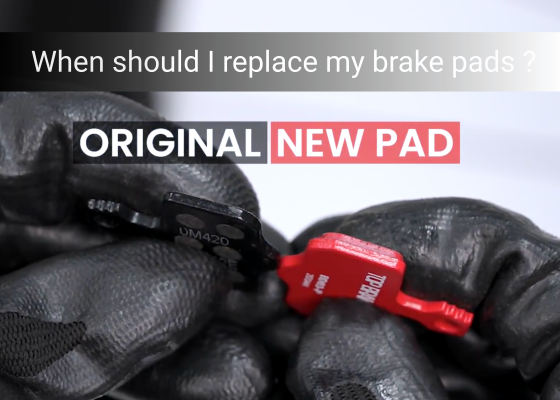When to Replace Your Bike Brake Pads: 3 Clear Signs You Shouldn’t Ignore
Your brake pads may be small, but they’re your bike’s most vital safety link.
Waiting until they squeal or lose power often means the damage is already done — to both pads and rotors.
Learn the three signs to replace your MTB brake pads and how to maintain smooth, consistent performance across XC, Trail, Enduro, and eMTB rides.
1.Braking Feels Weak or Requires More Lever Pull
If your braking feels soft, vague, or requires more lever pull, your pads are likely worn thin.
Modern MTB pads should be replaced when the friction material is less than 1 mm.
-
Inspect both sides of the caliper — uneven wear is common.
-
Thin pads overheat faster, transferring heat to the pistons and brake fluid.
-
When the material approaches 0.5 mm or less, stop riding immediately — it’s a danger zone that can lead to total brake fade and failure.
Pro Tip: Check pad thickness regularly — especially after wet, muddy, or high-descent rides.
2. Persistent Noise or Harsh Grinding Sounds
Noise tells a story — and your brakes are speaking to you.
A brief squeal after a wet ride is normal, but a persistent metallic or grinding sound means your pads are worn down to the backing plate.
Keep riding in this condition, and your rotors will suffer permanent damage.
Quick Fix: After every muddy or rainy ride, clean your rotors and pads with isopropyl alcohol — not degreaser or oil-based cleaners.
Worn or contaminated pads also create inconsistent friction, making braking unpredictable under different temperatures or moisture.
If your braking feels jerky or modulation is gone, your pads may be beyond saving.
3. Glazing, Uneven Wear, or Oil Contamination
When pads appear shiny, oily, or glazed, it means the friction surface has lost grip — often due to contamination from chain lube, brake fluid, or spray cleaners.
-
Lightly sanding can restore mild glazing.
-
Heavy contamination? Replace pads immediately.
Also check for uneven wear or sticky pistons, which cause uneven pressure and shorten pad lifespan.
A quick alignment check or piston clean-up can prevent premature wear.
4. How Long Do MTB Brake Pads Last?
The lifespan of your brake pads depends on far more than just material names.
Even pads labeled “sintered” or “resin” can vary greatly in performance depending on the brand’s formulation, production quality, riding style, and terrain conditions.
In other words, the true durability of your pads comes from how they’re engineered — not just what they’re made of.
Here’s a general reference for MTB riders:
| Riding Style | Recommended Pad Type | Key Differences & Considerations |
|---|---|---|
| XC / Trail | Resin or Top Brake Performance Series | Designed for lighter braking and balanced modulation. Lifespan depends on compound density and temperature tolerance — not all “resin” pads are created equal. |
| Enduro / Downhill | Sintered or Premium E+ Series | Built for high-heat conditions and aggressive braking. Inferior sintered pads may overheat or glaze faster; Top Brake compounds maintain stable friction under repeated descents. |
| e-MTB / Downhill | Graphene-Ceramic (e.g., Top Brake GraphEx Series) | Engineered for heavier bike loads and higher torque. Graphene technology enhances heat transfer and wear resistance, offering longer-lasting consistency than typical metallic or ceramic pads. |
Insight:
Material labels can be misleading — what truly defines performance is the compound engineering, binder purity, and heat-resistance formulation.
That’s why Top Brake compounds deliver more consistent braking, quieter operation, and extended durability even under extreme MTB conditions.
5.What Happens If You Don’t Replace Pads in Time?
Ignoring worn pads doesn’t just mean weaker braking — it risks:
-
Rotor warping or surface scoring
-
Caliper piston damage or fluid leaks
-
Brake fade and overheating on long descents
Replacing brake pads early is a small investment in safety that prevents costly repairs—and ensures every ride feels confident, quiet, and in control.
Final Thought
Brake pads are not just consumables — they’re your connection to safety and precision.
By inspecting them regularly and replacing them at the right time, you protect both your performance and your peace of mind.

